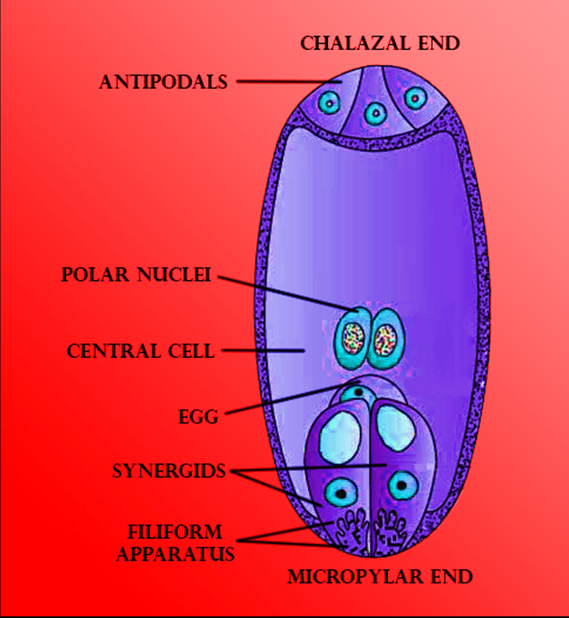
Answer
462.3k+ views
Hint: The first part of the answer provides nourishment to the egg cells. The second part of the answer is the immediate product of fertilization in an organism. The third part of the answer provides nourishment to the embryo.
Complete answer:
In embryo sac, n, 2n, 3n conditions are found respectively in antipodal, zygote, and endosperm. In a majority of flowering plants, one of the megaspores remains functional while the other three degenerate. Only the functional megaspore then develops into the female gametophyte or ‘embryo sac’.

When we observe the distribution of cells inside the embryo sac, we come to know that:
- There is a large central cell.
- At the micropylar end, 3 cells are grouped together to form an egg apparatus. The egg apparatus, in turn, consists of two synergids and one ‘egg cell’.
- Three cells at the chalazal end are together called ‘antipodals’. They are haploid.
Now, during double fertilization one of the male gametes moves towards the egg cell and fuses with its nucleus thus completing the ‘syngamy’. This results in the formation of a diploid cell, which is named as ‘zygote’.
While the other male gamete moves towards the two polar nuclei located in the central cell. Here, a fusion occurs among them to form a triploid ‘primary endosperm nucleus’ (PEN). As this process involves the fusion of three haploid nuclei, it is called ‘triple fusion’.
So, the correct answer is, ‘antipodal, zygote, and endosperm’.
Note:
-Each ovule has one or two protective envelopes. These are called integuments.
-Integuments encircle the nucellus from all the sides except at the tip where a small opening called the ‘micropyle’ is organized.
-Opposite the micropylar end, is the ‘chalaza’. It represents the basal part of the ovule.
-Since two types of fusions, syngamy and triple fusion take place in an embryo sac the whole phenomenon is termed ‘double fertilization’. This event is unique to flowering plants.
Complete answer:
In embryo sac, n, 2n, 3n conditions are found respectively in antipodal, zygote, and endosperm. In a majority of flowering plants, one of the megaspores remains functional while the other three degenerate. Only the functional megaspore then develops into the female gametophyte or ‘embryo sac’.

When we observe the distribution of cells inside the embryo sac, we come to know that:
- There is a large central cell.
- At the micropylar end, 3 cells are grouped together to form an egg apparatus. The egg apparatus, in turn, consists of two synergids and one ‘egg cell’.
- Three cells at the chalazal end are together called ‘antipodals’. They are haploid.
Now, during double fertilization one of the male gametes moves towards the egg cell and fuses with its nucleus thus completing the ‘syngamy’. This results in the formation of a diploid cell, which is named as ‘zygote’.
While the other male gamete moves towards the two polar nuclei located in the central cell. Here, a fusion occurs among them to form a triploid ‘primary endosperm nucleus’ (PEN). As this process involves the fusion of three haploid nuclei, it is called ‘triple fusion’.
So, the correct answer is, ‘antipodal, zygote, and endosperm’.
Note:
-Each ovule has one or two protective envelopes. These are called integuments.
-Integuments encircle the nucellus from all the sides except at the tip where a small opening called the ‘micropyle’ is organized.
-Opposite the micropylar end, is the ‘chalaza’. It represents the basal part of the ovule.
-Since two types of fusions, syngamy and triple fusion take place in an embryo sac the whole phenomenon is termed ‘double fertilization’. This event is unique to flowering plants.
Recently Updated Pages
Who among the following was the religious guru of class 7 social science CBSE

what is the correct chronological order of the following class 10 social science CBSE

Which of the following was not the actual cause for class 10 social science CBSE

Which of the following statements is not correct A class 10 social science CBSE

Which of the following leaders was not present in the class 10 social science CBSE

Garampani Sanctuary is located at A Diphu Assam B Gangtok class 10 social science CBSE

Trending doubts
A rainbow has circular shape because A The earth is class 11 physics CBSE

Fill the blanks with the suitable prepositions 1 The class 9 english CBSE

Which are the Top 10 Largest Countries of the World?

How do you graph the function fx 4x class 9 maths CBSE

The Equation xxx + 2 is Satisfied when x is Equal to Class 10 Maths

What is BLO What is the full form of BLO class 8 social science CBSE

Change the following sentences into negative and interrogative class 10 english CBSE

Give 10 examples for herbs , shrubs , climbers , creepers

Difference between Prokaryotic cell and Eukaryotic class 11 biology CBSE




